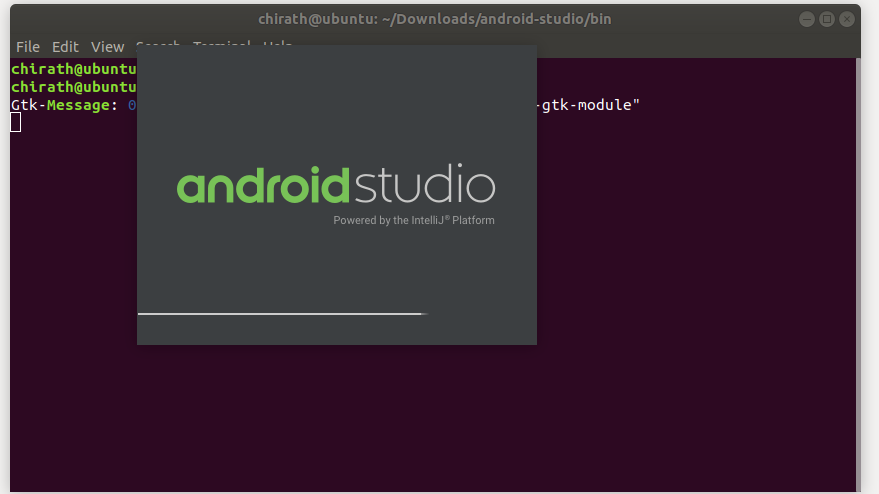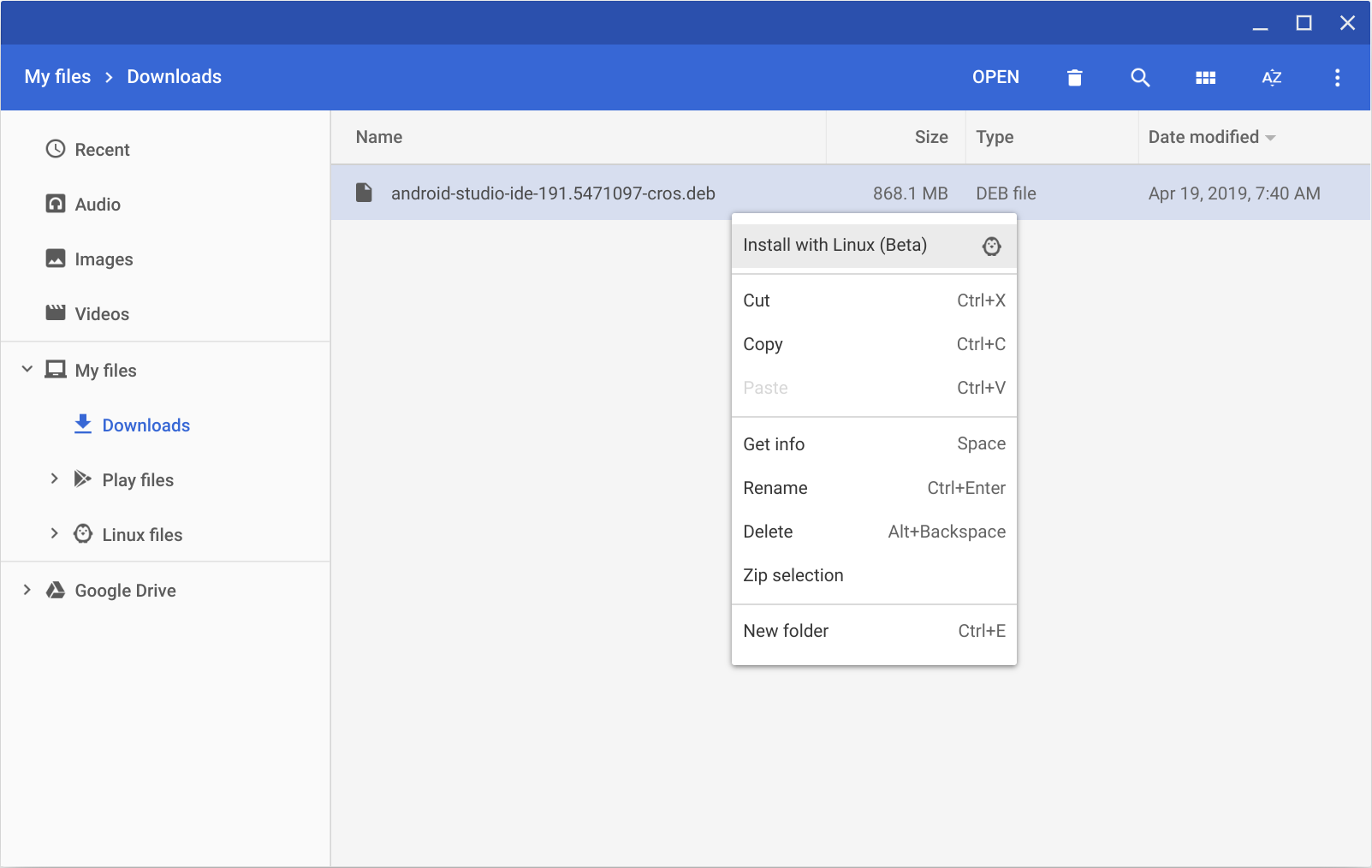SpaceScout Android is developed using Android Studio.
Before you can install Android Studio using Ubuntu Make you need to install it on your system. To install Ubuntu Make, enter the following command in the terminal. Sudo apt install ubuntu-make. After Ubuntu Make is set up, run the following command to install Android Studio in Ubuntu. Umake android. Apr 19, 2017 SpaceScout Android is developed using Android Studio. This is a working guide to get Android Studio up and runnning on Ubuntu. Android Studio is provided for free by Google and powered by the IntelliJ Platform. Use of Eclipse for Android development has since been deprecated. Android Studio.
This is a working guide to get Android Studio up and runnning on Ubuntu. Android Studio is provided for free by Google and powered by the IntelliJ Platform. Use of Eclipse for Android development has since been deprecated.
TOC
Install Java
Android Studio requires JRE 6 and Oracle JDK 7 (not OpenJDK) to function properly. Absence of JRE 6 will prevent it from starting. Absence of Oracle JDK 7 will prompt stability warnings.
Check the version(s) of Java you have.
If the result contains these:
you have what you need and you can skip to the next section. Else, continue to install Java
Update the package index.
Install JDK 6.
Install Oracle JDK 7. The Oracle JDK is the official JDK; however, it is no longer provided by Oracle as a default installation for Ubuntu.
Check that you have everything with
and you should see at least:
Install Android Studio
You have two options.
(1) Getting the package from Google
Go to the Android Developers site and download the full package (not just the SDK) into a directory of your choosing.
Unpack/Extract the ZIP file into the selected directory. Navigate to android-studio/bin/ in Terminal and run Android Studio
(2) Installing with apt-get
Provided by Paolo Rotolo
Student Developers should consult their supervisor before adding third-party repositories
If no prompt pops up, go to 'usr/share/applications' to find the .desktop and run the app. Right click on the icon on the desktop sidebar and 'Lock to Launcher'.
First-time Prompts
- Complete Installation I do not have..Unless you do.
- Android Setup Wizard
- Install Type Standard
- Emulator Settings (We'll deal with this in the next steps)
- License Agreement Accept android-sdk-license and Finish
Your Sdk folder will be in 'home/Android'
Update your Android Studio
- Go to Configure > Settings > Updates OR File > Settings > Updates
- Check 'Check for updates in channel'
- Set the channel to Stable Channel unless you're feeling adventurous.
- Check Now
Install the SDKs
Go to Configure > SDK Manager OR Tools > Android > SDK Manager
Install these packages:
Revisions are latest at the time of writing. Let's just say you'll take the latest of these or something similar.- Tools
- Android SDK Tools [Rev 24.1.2]
- Android SDK Tools Platform-tools [Rev 22]
- Android SDK Build-tools [Rev 21.1.2]
- Android SDK Build-tools [Rev 19.1]
- Android SDK Build-tools [Rev 19.0.3]
- Android 5.1
- Documentation for Android SDK [API 22, Rev 1] --useful to have
- SDK Platform [API 22, Rev 1]
- Google APIs [API 22]
- Google APIs Intel x86 Atom_64 System Image [API 22, Rev 1]
- Google APIs Intel x86 Atom System Image [API 22, Rev 1]
- Android 5.0.1 (API 21)
- SDK Platform [API 21, Rev 2]
- Google APIs [API 21, Rev 1]
- Google APIs Intel x86 Atom_64 System Image [API 21, Rev 4]
- Google APIs Intel x86 Atom System Image [API 21, Rev 4]
- Android 4.4.2 (API 19) --for Android KitKat minimum support
- SDK Platform [API 19, Rev 4]
- Google APIs (x86 System Image)
- Android 4.1.2 (API 16) --for Android JellyBean minimum support
- SDK Platform [API 16, Rev 5]
- Google APIs [API 16, Rev 3]
- Extras
- Android Support Repository [Rev 12]
- Android Support Library [Rev 22]
- Google Play Services [Rev 23]
- Google Repository [Rev 16]
Accept the agreements by selecting the top level paths.
- Tools
Install Intel's KVM for Better AVD Performance

The Android Virtual Device (AVD) lets you test the app on the computer instead of using your own device. 8GB of RAM seems to work well. This setup guide (based on Intel's) is mainly to make the AVD work fast and smooth using hardware virtualization.
Check if your processor supports hardware virtualization in Terminal:
Output 0 means no (sadface). If this is the case, you may prefer to use an actual Android device for testing. And you can skip the next steps of AVD.
Install cpu-checker
Check if your cpu supports kvm
If you see:
it means you can run your virtual machine faster with the KVM extensions. (Yeay)
But if you see
then you need to go to the BIOS Setup and enable VT.
Enabling VT (done with HP Compaq 8200)
- Restart the computer.
- Enter the BIOS Setup (Computer Setup in HP) by spamming F10 on startup.
- In Setup, go to Security > System Security.
- Enable these:
- Save changes and exit.
Install the KVM
You may ignore the Postfix Configuration prompt by selecting 'No Configuration'.
Add your local user account to the group kvm and libvirtd.
In Ubuntu 16.10, the group has been renamed to libvirt instead of libvirtd.
After the installation, you need to relogin so that your user account becomes an effective member of kvm and libvirtd user groups. The members of this group can run virtual machines.
Android Studio Requires
mksdcardutility to create AVD. If you're running64-bit LinuxOS. It won't have these packages installed by default.Install those packages.Verify installation in Terminal:
If you see:
installation was a success! Just a little bit more.
Add the emulator command line options.
In Android Studio, go to Run > Edit Configurations.
To set as global default for all projects, select 'Android Application' under 'Defaults'.
Go to the emulator tab, check 'Additional command line options' and add:
Create Your AVD
In Android Studio, go to Tools > Android > AVD Manager.
Click on 'Create Virtual Device'.
Choose a Phone (Nexus devices are pretty standard).
Choose a System Image. Lollipop (API 22) is the latest at the time of typing. The target should be 'Google APIs (Google Inc.)..' for our app to function with Google Maps.
In AVD (Verify Configuration),
- Check 'Use Host GPU'.
- Show Advanced Settings and make sure RAM is more than 1024 (but max at 1024 if your OS is 32-bit).
Finish. This shouldn't take too long..
Start up your AVD using Terminal. Navigate to your Android 'Sdk/tools' folder (usually in ~/Android). Put in the path to your 'Sdk/tools/lib' folder for 'LD_LIBRARY_PATH' below:
For those with a 32-Bit system, modify the command to below:
'Nexus_5_API_21' is a sample name for the AVD created. Replace it with your AVD's name replacing spaces with underscores.
It shouldn't take more than a minute to start up. If the screen goes all gibberish, just swipe up (Android Lollipop unlock gesture) and the home screen should appear before you.
Yeay! Now you can continue to setting up for Google Maps.
Trying to run the SpaceScout app at this point will most probably fail.
Android Studio For Linux
Hello everyone, today we have an awesome snap app for you to check out. Ever heard of Android Studio? Well a lot of you viewing this post probably have but now it is available for Linux as a Snap app meaning you can literally install it with a single click on your Ubuntu. Cool right?
As we type, there really isn’t anything that I would choose over Android Studio if I am developing apps for Android. Android Studio provides the fastest tools for building apps on every type of Android device. World-class code editing, debugging, performance tooling, a flexible build system, and an instant build/deploy system all allow you to focus on building unique and high quality apps.
What Is Android Studio About?
Android Studio is the official integrated development environment for Google’s Android operating system, built on JetBrains’ IntelliJ IDEA software and designed specifically for Android development.
Android Studio Features:
- Visual layout editor
Create complex layouts with ConstraintLayout by adding constraints from each view to other views and guidelines. Then preview your layout on any screen size by selecting one of various device configurations or by simply resizing the preview window.
- APK Analyzer
Find opportunities to reduce your Android app size by inspecting the contents of your app APK file, even if it wasn’t built with Android Studio. Inspect the manifest file, resources, and DEX files. Compare two APKs to see how your app size changed between app versions.
- Fast emulator
Install and run your apps faster than with a physical device and simulate different configurations and features, including ARCore, Google’s platform for building augmented reality experiences
- Intelligent code editor
Ubuntu Studio Download
Write better code, work faster, and be more productive with an intelligent code editor that provides code completion for Kotlin, Java, and C/C++ languages.
Can I Download Android Studio For Ubuntu 16 04 Download
Install Android Studio For Ubuntu
Android Studio Screenshots
Android Studio Video
Remember to like our facebook and our twitter @ubuntufree for a chance to win a free Ubuntu laptop every month!

Download Android Studio For Ubuntu 16.04 64 Bit
Quick Links: Download Scrcpy For Ubuntu | Download Podcasts For Ubuntu | Download Dashlane For Mac | Download Open Any File For Windows 10 | Download Bitwarden For Ubuntu | WeChat For Ubuntu | WhatsApp For Ubuntu | Ubuntu 18.04 ISO